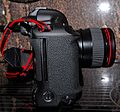Canon EOS-1D Mark III

|
|
| Type: | Digital autofocus / AE single lens reflex camera |
| Lens : | EF lenses |
| Lens connection : | Canon EF bayonet |
| Image sensor : | CMOS |
| Sensor size: | 28.1 mm x 18.7 mm |
| Resolution : | 10.1 megapixels |
| Image size: | 3,888 × 2,592 pixels |
| Pixel pitch (µm) : | 7.2 |
| Format factor : | 1.3 |
| Aspect ratio : | 3: 2 |
| File formats : | JPEG, CR2 (RAW format) |
| Exposure index : | Basic setting: 100–3,200, expandable to 50–6,400 in thirds or whole levels |
| Release delay : | 60 ms |
| Viewfinder : | Roof prism |
| Field of view : | 100% |
| Enlargement: | 0.76x, exit pupil 20mm |
| Screen : | TFT color monitor with live view (no autofocus) |
| Size: | 7.5 cm (3.0 ") |
| Resolution: | 230,000 pixels |
| Operating modes: | silent, single, 2 s, 10 s, 3 fps, 10 fps |
| Frame rate : | 10 frames per second max |
| Number of continuous exposures: | 30 RAW or 110 JPEG |
| Auto focus (AF) : | TTL area SIR with CMOS sensor |
| AF points: | Central cross sensor (cross up to sheet 4, line to sheet 8), 18 cross sensors (up to sheet 2.8, as a line to sheet 5.6), 26 line sensors (up to sheet 5.6) |
| AF measuring range: | EV −1 to +18 (at 23 ° C and ISO 100) |
| AF modes: | One shot, AI servo |
| Exposure metering : | Multi-field, selective, spot: central (3.8%), AF-linked or MultiSpot (up to 8 measurements), center-weighted integral |
| Measuring range: | EV 0-20 (at 23 ° C and EF 50mm 1.4 lens) |
| Regulation: | Program, aperture, aperture priority, manual exposure |
| Correction : | Manual: +/- 3 EV |
| Closure : | electronically controlled focal plane shutter |
| Shutter speed : | 30–1 / 8,000 s and Bulb X synchronization time 1/300 s |
| Lightning : | none |
| Guide number : | - |
| Flash control: | via camera menu, wireless Canon EX multiflash system |
| Lightning connection : | Standard ISO norm shoe |
| Synchronization : | 1st or 2nd shutter curtain |
| Exposure compensation : | +/- 3 EV in steps of thirds |
| Color space : | sRGB and Adobe RGB |
| White balance : | Auto Daylight Shade Cloudy Tungsten Fluorescence Flash Custom (5 settings) Color temperature |
| Storage media : | CompactFlash / SD memory card |
| Data interface : | USB 2.0 |
| Video interface: | Video output PAL and NTSC |
| Direct printing: | Yes |
| Power supply: | Lithium-ion battery LP-E4 11.1 V 2300 mAh; AC adapter ACK-E4; Car Battery Cable CG-570; |
| Casing: | Magnesium alloy |
| Dimensions: | approx. 156.0 mm × 156.6 mm × 79.9 mm |
| Weight: | approx. 1,155 g (body only) |
| Additions: | Dust and splash protection, up to 7-level lighting rows |
The Canon EOS-1D Mark III is a digital SLR camera from the Japanese manufacturer Canon , which has been available since May 2007. The manufacturer addresses them to professional users.
technical features
The camera has an APS-H - CMOS sensor with 10.1 megapixels, a 45-point autofocus and a 230,000 pixel 3-inch LC screen with adjustable brightness in 7 levels. It weighs 1210 g without lens and is compatible with all EF lenses, but not with the EF-S lenses.
The camera also has the following features:
- Self-cleaning sensor unit ( EOS Integrated Cleaning System )
- 45 point TTL autofocus - 19 with cross-type sensors
- ISO range from 100 to 3200, which can be expanded to 50 and 6400 via menu settings
- Weatherproof housing made of magnesium alloy
- Penta roof prism viewfinder that shows approx. 100% of the image
- Continuous recordings with up to 10 images per second (buffer memory for up to 110 images in JPEG format and a maximum of 30 images in RAW format)
- Two DIGIC-III image processors
GPS connection
A GPS device can be connected to the camera via the WFT-E2 data transmitter in order to record the exact location of each photo. The coordinates are saved in the Exif data of the image ( geo-imaging ).
Repairs by the manufacturer
There were complaints from users that the focus tracking was not accurate enough for moving objects. This could be traced back to a malfunction of the autofocus auxiliary mirror. The manufacturer offered a free repair program for this from December 2007. A publication by Canon Professional Service in March 2009, almost two years after the introduction of the camera , shows that the problems have not been completely resolved . Another repair program could finally solve the existing problems.
photos
See also
Individual evidence
- ↑ photoscala.de - AF problems with the EOS-1D Mark III
- ↑ http://cpn.canon-europe.com/content/product/message.do



